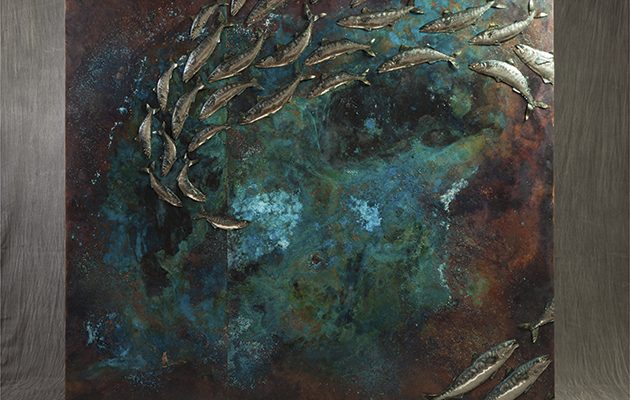The skill and exertion required to hammer out the fish for his sculptures is like playing and catching them all over again, Sam MacDonald tells Janet Menzies, with each one telling a story
Sam Macdonald catches his fish twice. First he actually catches the fish, and then he relives the experience sculpting it. Janet Menzies meets a sporting artist who is recreating in metal the fleeting moment shared between man and nature.
For more sporting artists, Clare Brownlow proves that inspiration can spring from anywhere, as indeed it did for her from an old pheasant tail feather, used by her father to write in his game journals. And Jolyon Madden‘s sporting art as attention grabbing as his front page splashes for The Sun.
SAM MACDONALD
Back in the day as a trainee cub reporter, I was taught: “a picture is worth a thousand words”. In fact, a picture is a thousand words. Each of Sam MacDonald’s bas-relief metalwork sculptures of fish is an extraordinary, complex narrative of a particular fish, its life and environment.
Sam MacDonald studied metalwork at London’s Camberwell College of Arts but he is an islander through and through, and it shows in his work. “I grew up on Lewis. My father is from Skye and my mother is from Orkney. As a child we had a river running right past the front door and I would spend hours watching the fish. I saw the little parr come up and they were so beautiful, so fast. No one fished in my family so I taught myself. Soon I was fishing off the wrecks in Lewis and then, when I moved to Orkney, I started diving. With the First World War wrecks, Orkney is a really fertile place for fish. You would see the fish through these big, obstructive shapes of the wrecks – just a small glimpse of a fish going through, a sudden flash of beauty, and you question whether you really saw that or not, and that’s what I really want to catch in my work.”
With metal as his medium, Sam MacDonald can recreate these fleeting images. The brass porthole framing a shoal of fish is indeed solid and the metallic quality of fish scales is captured with chemical colouring on various different metals. Initially starting with steel, MacDonald now favours pewter: “It is more malleable and it takes the colouring well. Over the years I have built up a series of different techniques and colouring methods. But it is all labour intensive. All the fish are hammered out by hand using traditional chasing and repoussé work. I like how that gives each fish an individual look – I wouldn’t want to cast them.
“When I am out fishing, every fish I catch has its own set of marks and scars, which tell its life history. The fish I make have that same narrative through the sculpting process. Every scale requires its own blows of the hammer; I counted the other day and a small herring took me 900 hammer blows.”
It is as if in sculpting his fish, Sam MacDonald is actually playing and catching it all over again. He agrees: “You might play a fish and make a mistake and lose it but that’s the experience and you enjoy learning from it. It is the same with the long, laborious process of making the sculpture. And you are telling the story of the fish at the same time. With a spent salmon, you are trying to show the great nobility of that old fish that has come back from who knows where in the ocean. I caught a trout once with a big scar up its back from where an osprey had caught it and dropped it and it had survived.
“There’s a great deal of detail hidden in my work. I like to leave people to discover things for themselves – and people who fish always spot what is going on. I did a piece with freshwater mussels and trout and in the background was a hawthorn in blossom. There were mayflies out. That ties the story to a particular time in a particular year, because it was so unusual for the hawthorn and the mayflies to be coinciding. This is an important part of the ethos of my work, because I think man is losing his understanding of the relationship between himself and the environment of wildlife. I want to get people engaging with nature in a more honest way.”
MacDonald’s work first came to attention when he was featured in the BBC2 series Coast. Now his next big challenge is a trip to Iceland. “I love the light in Iceland,” he says. “I am a northern kind of person and I feel at home in Iceland. I love to see it with the big grey clouds and then when the clouds break you have the volcanos and these very dark rocks.”
It is an environment well-suited to the solid, almost harsh, quality of much of MacDonald’s work. “The process of working in metal is quite tight and technical. I like the limitations and discipline that metal puts on me. You can’t take things for granted.”
See Sam MacDonald’s work online at www.sam-macdonald.co.uk or look out for him exhibiting at House of Bruar, Blenheim Horse Trials and various country shows.





